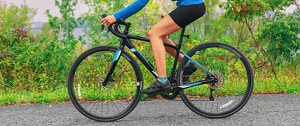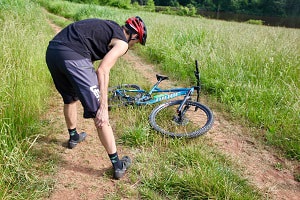Bike seat height matters and can directly impact your performance when biking. Having the right height for your bike seat enables you to transfer power from your legs to the pedals with ease. It allows you to move forward without straining your legs too fast.
How high should my bike seat be? Well, this guide will help you determine the right bike seat height for you. With this, you will be able to identify whether your bike seat is too high or too low for your needs.
This includes correcting your saddle, checking the fore/aft saddle position, and ensuring the right top tube and stem length. These steps will help you achieve the right comfort level you need when cycling.
Table of Contents
What Happens if You Use the Wrong Bicycle Seat Height
Having the right bicycle seat height allows you to maintain good posture when biking. It helps align your back, shoulders, arms, and legs in a biking position. The number one negative result of a wrong seat height is bad posture and muscular strain.
Here are the most specific issues you could encounter with the wrong bike seat height:
Strain on your knees
One of the main culprits of having strained knees after biking is the seat height. If it is positioned badly and placed at a wrong angle, you will most probably experience a strain on your knees.
With the wrong placement, you might overreach your pedals when seated. You might also lean too hard and exert more effort trying to gain access to the bike handlebars.
Pain in the lower back
Another negative result of a wrong road bicycle seat height is pain on your lower back. If your bike seat height is not properly aligned with the handlebars, it will be hard to reach the bars properly. You will put more effort to get access with the handlebars and can hurt your lower back. Your lower spinal cord will be stretched out and receive too much strain with the wrong bike seat height.
Pain in the hamstring
Badly positioned seat height also causes damage to your hamstrings. If the height of your bike seat is too low, it can significantly damage your bones and muscles. Your thighs will experience discomfort when the seat is too lowered.
Discomfort in the calf
Another part of your body that would experience pain is your calf muscles. When the seat height is too high or too low, you cannot pedal conveniently, and the muscles in the calf area can feel pain. Wrong seat height pushes you to put more effort in pedaling, which, in turn, pressures your calf muscles.
Setting Your Bike Seat Height
There are different ways to set your bike seat height properly so you can be more comfortable and at ease when riding on your bike without worrying about sore muscles and bike fatigue.
Holmes method
The Holmes method is one of the most precise and accurate ways of adjusting bike seat height. You have to take notice of your feet on the pedal when employing this method. Your knee should be angled between 25-36 degrees while the pedal is set at its lowest position.
In case you have knee issues, it is ideal to get an angle close to 25 degrees. If you observe that your knees are bent more than 30 degrees, it is vital that you lower your bike saddle.
Pro method
For this technique you need to consult with an expert or employ a full professional bike fitting. It is important to check the positions or placement of your bike handlebars and seat.
To do this, you can ride on your bike and adjust the fitting of both handlebars and seat. Observe how your body reacts or whether you experience discomfort after adjusting. If so, re-adjust if necessary while taking into consideration your knees and lower back position.
Heel method
If you want the simplest way to correct the bike seat height, you should resort to the heel method. For this, it is necessary to stand right next to your bicycle, and raise the bike saddle in line with your hip.
After that, you can sit on the bike, and reach the pedal using your heel. Take note that the crank arm should be aligned with the seat which should also be pointing to a downward position. To determine whether the seat’s height is correctly placed, your legs must be straight and not extend your knee too much.
Lemond Method or the 109% Method
This technique is more scientific. It employs a certain formula that measures the proper bike seat height for your stature. It is more preferable than the heel method, as well.
To do this, you need to stand against the wall, get a thick book and place it between your legs. Then, you have to pull the book upwards where you feel more comfortable. If still not satisfied, check this article to know the reasons why bike seats are uncomfortable and how to make a bike seat more comfortable here.
Afterward, mark the placement of the book, and measure the distance and the ground in millimeters. Calculate the height of your saddle, and get the 109% of the inseam.
Checking the Right Height
Correct saddle
To determine whether you have the correct saddle, pay attention to the heel. Your heel should graze the pedal in a 6 o’clock position once the pedal is at the lowest position.
If you feel any sort of discomfort at the front knee, it is important to adjust or raise the saddle moderately. However, if the pain you feel is at the back knee, you must drop the saddle slightly. You should make subtle changes of about 2mm when adjusting.
Correct fore/aft saddle position
To get the right fore/aft saddle position, you must sit well in the center of the bike saddle while ensuring the crank arms are in horizontal position. Use a plumb line coming from the front of your forward kneecap to get to the neutral position. Ensure that it should be touching the end of the crank arm properly. Your knee must be above the pedal spindle once the crank arm is in the 3 o’clock position.
Correct top tube and stem length
The right height of the top tube and stem length also determines your comfort level. If you are sitting comfortably on the bike and your elbows are slightly bent while hands on the brake hoods, it shows that you are in an upright position. It means that you might need a longer step to reduce discomfort on your lower back.
Conclusion
Comfort is the key for a more fun and enjoyable bike ride. The seat height has a direct impact on the level of convenience and comfort when cycling. Having the correct bike seat height that compliments your stature or anatomy is very important.
May the tips we mentioned above give you an idea on how high should my bike seat be and how you can significantly adjust your seat height. In this way, you will reduce your discomfort and prevent damaging your legs, lower back and even shoulders.

“I ride my bike to work for years, but is that enough? Our carelessness towards our surroundings has taken a toll on the environment. And now, everyone is responsible for changes; even the most minor contribution is counted. With this hope and spirit, I started with my partner to establish Biketoworkday to help more individuals commute to their work sites on their bikes.”





